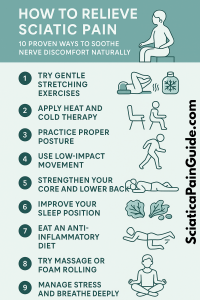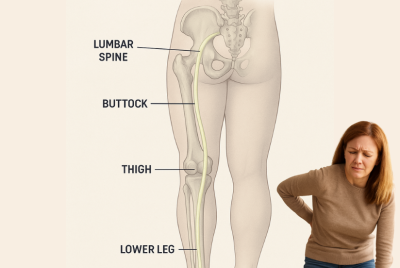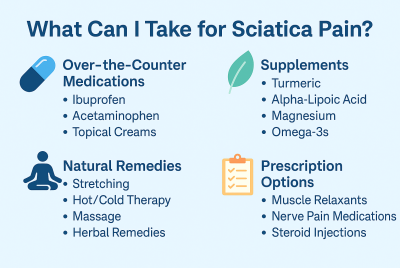How to Relieve Sciatic Pain: 10 Proven Ways to Soothe Nerve Discomfort Naturally
When Sciatica Takes Over Your Life
If you’ve ever felt a sharp, burning pain shooting from your lower back down your leg — or that numb, tingling feeling that makes sitting unbearable — you know how relentless sciatic nerve pain can be. Sciatica affects up to 40% of Americans at some point in their lives. Whether it’s caused by a herniated disc, muscle tension, or inflammation pressing on the sciatic nerve, finding relief can feel like a full-time job. The good news? You don’t always need medication or surgery to feel better. There are simple, science-backed ways to relieve sciatic pain naturally — right from home. Let’s explore 10 proven methods for how to relieve sciatic pain that can ease your discomfort, restore mobility, and help you take control of your day again.
Understanding Sciatica: Why It Hurts So Much
The sciatic nerve is the largest nerve in the human body. It runs from your lower spine, through your hips and buttocks, down both legs. When something compresses or irritates this nerve, you feel pain — sometimes mild and achy, other times sharp, stabbing, or electric.
Common causes of sciatica include:
-
Herniated or bulging discs
-
Spinal stenosis (narrowing of the spine)
-
Piriformis syndrome (tight hip muscles)
-
Poor posture or prolonged sitting
-
Muscle weakness or inflammation
Sciatica pain usually affects one side of the body and can make even simple activities — like sitting, bending, or walking — feel impossible.
The key to lasting relief is reducing nerve pressure and inflammation while strengthening the muscles that support your spine.
🧘♀️ 10 Proven Ways to Relieve Sciatic Pain Naturally
1. Try Gentle Stretching Exercises
Stretching is one of the most effective natural remedies for sciatica. It releases pressure on the nerve, improves flexibility, and relaxes tight muscles.
Best beginner stretches for sciatica relief:
-
Knee-to-chest stretch – Eases tension in the lower back.
-
Piriformis stretch – Loosens the deep hip muscle that can pinch the sciatic nerve.
-
Cat-Cow stretch – Increases spinal mobility.
-
Child’s Pose – Relaxes the spine and calms nerve pain.
👉 Do each stretch slowly, holding for 20–30 seconds, and repeat twice per day.
2. Apply Heat and Cold Therapy
Alternating between heat and ice is a classic way to reduce sciatic pain.
-
Cold packs reduce inflammation and numb sharp pain.
-
Heat therapy relaxes muscles and boosts blood flow for healing.
Tip:
-
Apply a cold pack for 15–20 minutes, followed by gentle heat for another 15 minutes.
-
Repeat 2–3 times daily for best results.
3. Practice Proper Posture
Poor sitting posture — especially slouching — can aggravate sciatic nerve compression.
Posture tips:
-
Sit with both feet flat on the floor.
-
Keep your back supported and avoid crossing your legs.
-
Use a lumbar cushion or rolled towel behind your lower back.
👉 A small ergonomic change can significantly reduce daily pain.
4. Use Low-Impact Movement (Stay Active!)
Resting for too long actually worsens sciatica. Gentle movement keeps your muscles flexible and your discs healthy.
Recommended low-impact exercises:
Start small — even a 10-minute walk can help reduce stiffness and inflammation.
5. Strengthen Your Core and Lower Back
Weak abdominal and back muscles make it easier for spinal pressure to affect the sciatic nerve. Strengthening them can prevent future flare-ups.
Try:
-
Pelvic tilts
-
Glute bridges
-
Bird-dog exercise
These moves support your lower spine and reduce nerve compression.
6. Improve Your Sleep Position
Sleeping incorrectly can make sciatica worse overnight.
Best sleep positions:
-
Side sleeping: Place a pillow between your knees to align your spine.
-
Back sleeping: Put a pillow under your knees to ease pressure on your lower back.
-
Avoid stomach sleeping — it strains your spine.
A medium-firm mattress is ideal for sciatic pain.
7. Eat an Anti-Inflammatory Diet
Inflammation plays a big role in sciatica. The right foods can help reduce swelling and speed healing.
Eat more of:
-
Fatty fish (salmon, sardines)
-
Leafy greens (spinach, kale)
-
Berries, turmeric, and olive oil
-
Nuts and seeds
Avoid:
-
Processed foods, sugar, and refined carbs
-
Fried or fatty foods
👉 A healthy diet supports overall nerve health and pain reduction.
8. Try Massage or Foam Rolling
Massage therapy helps release tension in the piriformis and lower back muscles that often compress the sciatic nerve.
You can also use a foam roller or tennis ball to gently massage tight spots in your glutes and thighs.
-
Roll slowly over each area for 1–2 minutes.
-
Stop immediately if pain increases.
Regular massage improves circulation and helps break up muscle stiffness.
9. Manage Stress and Breathe Deeply
Stress causes muscle tension and inflammation — two major triggers for sciatic pain.
Simple relaxation techniques help calm the nervous system and reduce pain perception:
-
Deep belly breathing
-
Meditation or mindfulness
-
Gentle yoga
-
Listening to calming music
Fun fact: Stimulating the vagus nerve through deep breathing and humming may also lower inflammation linked to nerve pain.
10. Seek Professional Help When Needed
If home treatments aren’t enough, consult a professional.
Options include:
-
Physical therapy: Builds flexibility and strength.
-
Chiropractic care: Aligns the spine to relieve pressure.
-
Acupuncture: May reduce nerve inflammation naturally.
-
Medical treatment: In severe cases, steroid injections or surgery might be considered.
Don’t wait too long if your pain is severe — early treatment can prevent long-term nerve damage.
⚠️ When to See a Doctor Immediately
Seek medical attention if you experience:
-
Sudden, severe pain that doesn’t improve
-
Weakness or numbness in your leg or foot
-
Loss of bladder or bowel control
-
Sciatic pain after an injury or fall
These may indicate a more serious condition, such as a herniated disc or nerve compression that needs prompt care.
💡 Lifestyle Changes for Long-Term Sciatica Relief
For lasting results, combine short-term pain relief with long-term prevention habits:
-
Move regularly: Avoid sitting for hours at a time.
-
Stay hydrated: Water keeps spinal discs healthy.
-
Maintain a healthy weight: Reduces pressure on the lower spine.
-
Quit smoking: Smoking restricts blood flow to spinal tissues.
-
Stretch daily: 10 minutes a day can prevent flare-ups.
Building these habits into your routine helps protect your back and minimize future pain.
🧠 Quick “At-Home Sciatica Relief Routine” (5 Minutes Daily)
Morning:
-
Cat-Cow Stretch (30 seconds)
-
Knee-to-Chest Stretch (30 seconds per side)
Afternoon:
-
Short 10-minute walk
-
Seated hamstring stretch
Evening:
-
Piriformis stretch (30 seconds per side)
-
Warm compress on lower back (10 minutes)
This mini routine keeps your muscles loose, your blood flowing, and your sciatic nerve happy.
FAQs About How to Relieve Sciatic Pain
1. What is the fastest way to relieve sciatic pain?
Cold packs, gentle stretching, and proper posture can offer fast relief. For long-term results, combine exercise and anti-inflammatory foods.
2. Can I walk with sciatic pain?
Yes, light walking can reduce stiffness and improve circulation — just avoid hills or uneven terrain.
3. What should I avoid doing with sciatica?
Avoid sitting for long hours, heavy lifting, and twisting motions that can worsen nerve compression.
4. How long does sciatica pain last?
Most mild cases improve within 4–6 weeks. Chronic cases may take longer, especially if caused by disc or spine issues.
5. Can stretching cure sciatica?
Stretching relieves pain by reducing nerve pressure, but underlying causes may still need medical care or therapy.
6. Is heat or ice better for sciatica?
Use ice for inflammation and heat for muscle relaxation. Alternating both works best for most people.
7. Can stress make sciatica worse?
Yes. Stress increases tension and inflammation, which can irritate the sciatic nerve. Breathing exercises and relaxation techniques help.
Conclusion: Relief Is Possible — Start Today
Sciatic pain can be frustrating, but it’s not permanent. By combining gentle stretches, lifestyle changes, proper posture, and stress reduction, you can dramatically reduce nerve pain and prevent flare-ups.
Remember — consistency is key. Even five minutes of movement or mindful breathing each day can make a difference in how you feel tomorrow.
You deserve a life free from pain — and it starts with taking small, intentional steps today.
Disclaimer
This article is for informational purposes only and is not a substitute for professional medical advice, diagnosis, or treatment. Always consult your healthcare provider before beginning new exercises or treatments for sciatic pain.

- Tingling in Foot Sciatica Home Remedies
- 10 Proven Home Remedies for Sciatica Pain Relief Without Medication
- Sciatica Pins and Needles Relief





